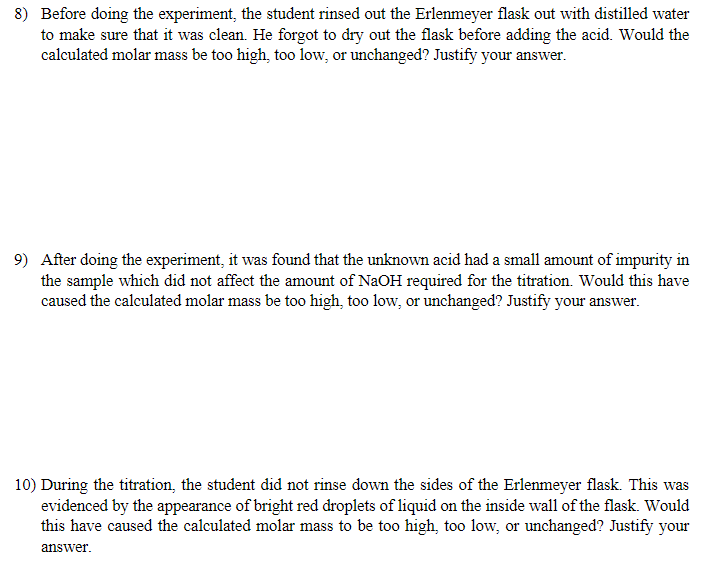Answered step by step
Verified Expert Solution
Question
1 Approved Answer
Please do parts 1 - 10 please. Thank you! A student wanted to determine the molar mass of an unknown monoprotic acid. The student had


Please do parts 1 - 10 please. Thank you!
A student wanted to determine the molar mass of an unknown monoprotic acid. The student had a standard NaOH solution which had a molarity of 0.111 M. The student weighed an empty weighing boat. The acid was then added and transferred to the Erlenmeyer flask. The weighing boat was weighed again. Twenty milliliters of distilled water was added to the Erlenmeyer flask to dissolve the acid. The NaOH was added to the buret after cleaning with distilled water and then rinsing with the standard NaOH solution. Two drops of indicator (phenolphthalein) were added to the flask. The following data was collected Weight of Empty Tray Weight of Tray + Acid Weight of Tray after Transfer Initial Volume of NaOH Final Volume of NaOH 9.786 grams 10.648 grams 9.883 grams 0.15 mL 31.63 mL. 1) How many grams of the unknown acid were added to the flask? You must show your work. 2) How many milliliters of NaOH were used in this titration? You must show your work 3) How many moles of NaOH were used in this titration? You must show your work. 4) How many moles of the unknown acid were in the flask? You must show your work. 5) What is the molar mass of the unknown acid? You must show your work. 6) What is the evidence that the equivalence has been reached in this titration? Be specific. 7) What precaution did the student have to take in determining the mass of the unknown acid? Be specific 8) Before doing the experiment, the student rinsed out the Erlenmeyer flask out with distilled water to make sure that it was clean. He forgot to dry out the flask before adding the acid. Would the calculated molar mass be too high, too low, or unchanged? Justify your answer. 9) After doing the experiment, it was found that the unknown acid had a small amount of impurity in the sample which did not affect the amount of NaOH required for the titration. Would this have caused the calculated molar mass be too high, too low, or unchanged? Justify your answer. 10) During the titration, the student did not rinse down the sides of the Erlenmeyer flask. This was evidenced by the appearance of bright red droplets of liquid on the inside wall of the flask. Would this have caused the calculated molar mass to be too high, too low, or unchanged? Justify yourStep by Step Solution
There are 3 Steps involved in it
Step: 1

Get Instant Access to Expert-Tailored Solutions
See step-by-step solutions with expert insights and AI powered tools for academic success
Step: 2

Step: 3

Ace Your Homework with AI
Get the answers you need in no time with our AI-driven, step-by-step assistance
Get Started


